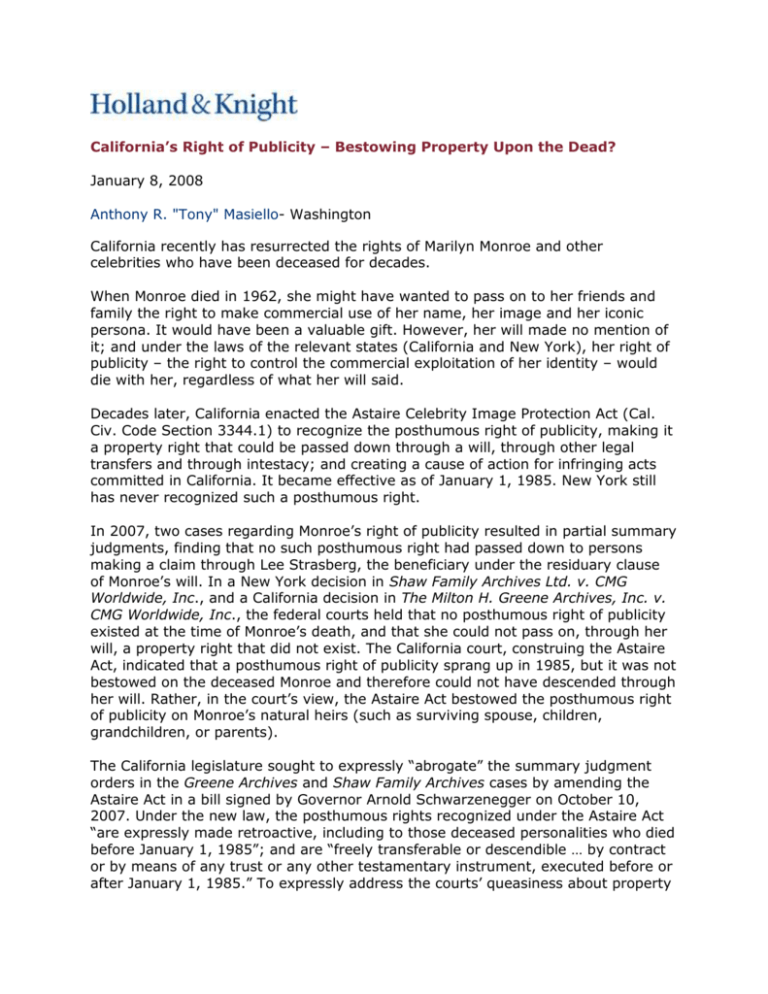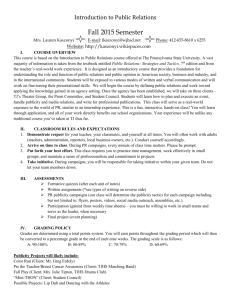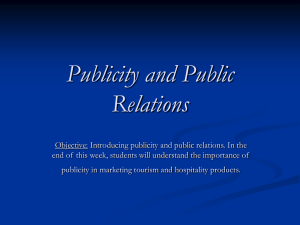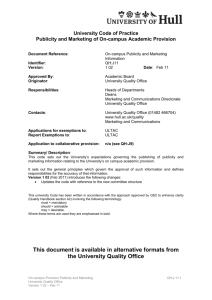postumous right of p..
advertisement

California’s Right of Publicity – Bestowing Property Upon the Dead? January 8, 2008 Anthony R. "Tony" Masiello- Washington California recently has resurrected the rights of Marilyn Monroe and other celebrities who have been deceased for decades. When Monroe died in 1962, she might have wanted to pass on to her friends and family the right to make commercial use of her name, her image and her iconic persona. It would have been a valuable gift. However, her will made no mention of it; and under the laws of the relevant states (California and New York), her right of publicity – the right to control the commercial exploitation of her identity – would die with her, regardless of what her will said. Decades later, California enacted the Astaire Celebrity Image Protection Act (Cal. Civ. Code Section 3344.1) to recognize the posthumous right of publicity, making it a property right that could be passed down through a will, through other legal transfers and through intestacy; and creating a cause of action for infringing acts committed in California. It became effective as of January 1, 1985. New York still has never recognized such a posthumous right. In 2007, two cases regarding Monroe’s right of publicity resulted in partial summary judgments, finding that no such posthumous right had passed down to persons making a claim through Lee Strasberg, the beneficiary under the residuary clause of Monroe’s will. In a New York decision in Shaw Family Archives Ltd. v. CMG Worldwide, Inc., and a California decision in The Milton H. Greene Archives, Inc. v. CMG Worldwide, Inc., the federal courts held that no posthumous right of publicity existed at the time of Monroe’s death, and that she could not pass on, through her will, a property right that did not exist. The California court, construing the Astaire Act, indicated that a posthumous right of publicity sprang up in 1985, but it was not bestowed on the deceased Monroe and therefore could not have descended through her will. Rather, in the court’s view, the Astaire Act bestowed the posthumous right of publicity on Monroe’s natural heirs (such as surviving spouse, children, grandchildren, or parents). The California legislature sought to expressly “abrogate” the summary judgment orders in the Greene Archives and Shaw Family Archives cases by amending the Astaire Act in a bill signed by Governor Arnold Schwarzenegger on October 10, 2007. Under the new law, the posthumous rights recognized under the Astaire Act “are expressly made retroactive, including to those deceased personalities who died before January 1, 1985”; and are “freely transferable or descendible … by contract or by means of any trust or any other testamentary instrument, executed before or after January 1, 1985.” To expressly address the courts’ queasiness about property posthumously bestowed upon the dead, the new law states, “The rights recognized under this section shall be deemed to have existed at the time of death of any deceased person who died prior to January 1, 1985.” And to expressly address the claimants to Ms. Monroe’s rights through Lee Strasberg, the new law provides that such rights, if not mentioned in a will, will descend by operation of the will’s residuary clause. The rights under the Astaire Act are not perpetual; they expire 70 years after the deceased personality’s death. The right of publicity, or the right to control the commercial exploitation of one’s name, image, voice and other elements of one’s personality, is available not only to celebrities but to everyone. However, only 28 of the 50 states recognize a common law or statutory right of publicity among the living, and fewer recognize such a right surviving death. The right of publicity, to the extent it exists, is closely related to the right of privacy, and for non-celebrities its primary purpose may be to protect against undue invasion of privacy for commercial purposes. Trademark laws provide an opportunity for perpetual protection of a name or image, and some celebrities’ successors have made use of this avenue to extend exclusive commercial exploitation rights beyond those available under the right of publicity. Unlike the right of publicity, trademark rights arise from active commercial exploitation of the name or image as a trademark, and they can disappear when such use is discontinued. They are also typically limited to the specific fields of business in which the trademark owner is active, whereas the right of publicity applies to virtually all fields of commercial use. For more information, email Anthony R. Masiello at anthony.masiello@hklaw.com or call toll free, 1-888-688-8500. The Statutory Right of Publicity for Deceased Celebrities in California and the Impact of Sb 771 Mr. Zuber is a partner of Zuber & Taillieu LLP, where he specializes in patent and trademark transactions. He earned a J.D. from Columbia Law School, an M.P.P. from Harvard University, and a B.S. in engineering from Rutgers University. Creation of the Right of Publicity in California The “right of publicity” is generally defined as the right to control or prevent the unauthorized use or commercial exploitation of one’s name, likeness, voice or “personality.”[1] The right of publicity evolved from the right of privacy, which itself has evolved dramatically over more than a century. In 1890, Samuel D. Warren and Louis D. Brandeis published a seminal article in the Harvard Law Review entitled The Right to Privacy,[2] in which they argued for a remedy for those injured by unauthorized public disclosure of truthful but embarrassing private facts.[3] By the mid 1900’s, some courts and state legislatures had adopted some elements of the Brandeis-Warren theory. However, the question arose as to how to apply these rights to celebrities who had voluntarily and affirmatively sought the spotlight. Second Circuit Judge Jerome Frank answered that question in 1953 when he coined the term “right of publicity” in the case of Haelan Laboratories Inc. v. Topps Chewing Gum, Inc. [4] The Haelan case asked whether a baseball player could assign exclusive rights to produce a card with his photograph on it to one single baseball card manufacturer.[5] The court determined that prominent persons do possess a “right of publicity”[6] which was an assignable interest, unlike the strictly personal – and therefore non-assignable -- right to privacy.[7] Judge Frank’s opinion was followed by a prominent article by Professor Melville B. Nimmer that analyzed the right to publicity as an assignable property right.[8] Nimmer explained that a mere right to privacy did not sufficiently address the issues unique to celebrities; while the right to privacy protected individuals from indignity and embarrassment, the right to publicity dealt with a celebrity’s ability (and, theoretically, anyone’s ability) to protect the commercial value of his or her image and identity.[9] California first codified the right of publicity in 1971, when the California legislature enacted Civil Code section 3344, which enables recovery by any living person whose name, photograph, or likeness has been used for commercial purposes without his or her consent.[10] California courts have recognized both the statutory and the common law right of publicity. [11] However, both the common law and statutory rights of privacy were only available to living plaintiffs; the right was not freely descendible and thus expired by operation of law upon the death of the person claiming the right.[12] This very issue lay at the heart of two seminal companion cases decided in 1979: Lugosi v. Universal Pictures[13] and Guglielmi v. Spelling-Goldberg Productions.[14] In those cases, the California Supreme Court determined that the heirs of deceased celebrities had no statutory protections against posthumous exploitation of the celebrity’s image. In Lugosi, the heirs of actor Bela Lugosi (best known for playing the title role in the 1930 movie, “Dracula”) sued to enjoin and recover profits from Universal Pictures for licensing Lugosi’s name and image on merchandise.[15] The California Supreme Court upheld the decision of appellate court in finding that the right to exploit one’s name and likeness is personal and must be exercised, if at all, by him during his lifetime.[16] Similarly, in Guglielmi, the California Supreme Court cited to and relied upon its opinion Lugosi in holding that Rudolph Valentino’s heirs could not obtain an injunction or damages from the defendant because Valentino’s right of publicity was not descendible under California law.[17] Because Valentino had not exploited his name and likeness during his lifetime, others could now use it without liability to Valentino’s heirs.[18] Courts outside of California honored the Lugosi and Guglielmi decisions as well in applying California law. In Groucho Marx Productions, Inc. v. Day and Night Company, Inc.[19], the Second Circuit held that the rights of publicity were not descendible under California law. In that case, the Marx Brothers’ assignees sued a production company for interference with the assignees’ publicity rights; the production company incorporated three characters that strongly resembled the Marx Brothers in its Broadway musical, “A Day in Hollywood/ a night in the Ukraine.” The federal district court in New York had applied New York law, determining that New York recognized a descendible right to publicity and granting summary judgment to the plaintiffs.[20] The Second Circuit, however, reversed that decision, holding that the descendibility issue was governed by California law and as a result, the plaintiffs had no right to relief.[21] Legislating a Post-Mortem Right of Publicity The holdings in Lugosi and Guglielmi precipitated legislation designed specifically to create a statutory descendible right to publicity. In 1984, the California legislature enacted Civil Code section 990 (renumbered as section 3344.1 in 1999), creating a post-mortem right of publicity for “deceased personalities,” – individuals whose names, voices, signatures, photographs, or likenesses had commercial value as of the time of their death.[22] This legislation became effective January 1, 1985. Section 990 explicitly stated that the right of publicity is a property right, “freely transferable, in whole or in part, by contract or by means of trust or testamentary documents” whether that transfer occurs before, by or after death of the personality.[23] The statute held that absent an explicit transfer of this right, it automatically goes to the statutory/ intestate heirs of the deceased (spouse, children, parents).[24] If the celebrity fails to transfer the right explicitly and dies without any statutory heirs, the right of publicity terminates.[25] Otherwise, the extended right of publicity would expire 50 years after the death of the deceased personality.[26] In an attempt to maximally preserve First Amendment protections for creative outlets, the new statutory provision exempted from liability plays, books, magazines, newspapers, musical compositions, films, and radio and television shows that used a deceased celebrity’s likeness, name, voice, etc.[27] The registered owner of the posthumous rights to The Three Stooges comedy act relied on section 990 to obtain damages against an artist who reproduced his charcoal drawings of the act on lithographs and t-shirts.[28] The artist had claimed that his artwork was creative and transformative enough to warrant First Amendment protection against the plaintiff’s right of publicity claim, just like the specifically listed exemptions in the statute. The court agreed that when a work of art is so transformative that the value of the work derives primarily from the skill and creativity of the artist rather than from the fame of the celebrity depicted, the work may be protected by the First Amendment.[29] However, the court determined that Saderup’s depictions were more literal than transformative -- a clear attempt merely to exploit the Three Stooges’ fame -- and therefore First Amendment protection did not apply.[30] If Saderup wanted to continue to use these images, he needed to obtain the consent of the right of publicity holder. However, that same list of exempt uses in section 990 posed new problems, exemplified in two main cases: In Joplin Enterprises v. Allen,[31] a federal district court applied section 990 to find that a two-act biographical play about deceased singer Janis Joplin was not actionable. Joplin’s devisees alleged that the play constituted copyright infringement as well as misappropriate of Joplin’s privacy and publicity rights.[32] The court determined that section 990 applied only to unauthorized “merchandise, advertisements and endorsements,” and it explicitly exempted plays from liability.[33] The Ninth Circuit similarly exempted an instructional dance video from liability under section 990 in Astaire v. Best Film & Video Corp.[34] In Astaire, the widow of famed dancer Fred Astaire sued a videotape manufacturer for using Fred Astaire’s image in a series of dance instructional videotapes – each tape opened with about 90 seconds of footage of Astaire. Mrs. Astaire claimed the company violated her statutory right to control the use of her husband’s name and likeness under section 990.[35] The Central District of California agreed with Mrs. Astaire, finding that the company used Astaire’s image “on or in products, merchandise, or goods” in violation of the statute.[36] But the circuit court reversed and remanded, finding that the prerecorded videotapes fell into the “film” exemption of section 990(n).[37] Indeed, the court determined that the film exemption applied even if the use was an advertisement or commercial announcement.[38] The Astaire Amendment: Deleting exempt uses After losing her difficult and expensive lawsuit, Mrs. Astaire teamed up with the Screen Actors Guild to sponsor legislation that would clarify and expand the postmortem right of publicity. That bill, SB 209, passed in 1999 and became known as the “Astaire Celebrity Image Protection Act.” Most significantly, the Astaire Amendment eliminated the list of exempt uses of deceased celebrity likenesses, thereby substantially increasing the types of uses for which consent of the celebrity’s heirs is required. The bill also extended the descendible right of publicity from 50 years to 70 years following the celebrity’s death.[39] Despite these amendments to clarify and expand the descendible posthumous right of publicity, there remained a gap in the law that was revealed by two similar cases regarding the posthumous rights of Marilyn Monroe: Milton H. Greene Archives, Inc. v. CMG Worldwide, Inc.[40] and Shaw Family Archives, Ltd. v. CMG Worldwide, Inc.[41] (collectively, the “Monroe cases”). When Marilyn Monroe died, she left the residue of her estate to her acting coach, Lee Strasburg, who, upon his death, left most of his estate to his wife, Anna Strasberg.[42] Anna Strasberg then transferred her interest in Monroe’s estate to Marilyn Monroe LLC, who licensed CMG Worldwide, Inc. to use Monroe’s images and likenesses.[43] In these two actions, CMG sued other parties for their unauthorized use of Monroe’s image. In the Monroe cases, both courts interpreted section 3344.1 as prohibiting publicity rights from passing by will if the personality died prior to January 1, 1985.[44] In other words, the statutory descendible right of publicity did not exist when Monroe died, so, by operation of law, it could not have been a property right that she possessed upon death.[45] Because Monroe did not own this property right at the time of her death, she could not have transferred it in the residuary clause in her will.[46] Moreover, even if Monroe did possess the right, section 3344.1 only enables transfers to statutory heirs – Monroe had no statutory heirs, so her right would terminate in any event.[47] Both courts ruled against CMG on summary judgment. The holdings in the Monroe cases had unsettling implications. Many deceased celebrities and their devisees left or transferred residual estates to charitable organizations, which relied in part on their ability to license the famous images for fundraising purposes. The Monroe holdings effectively removed from these organizations many rights they had relied upon. Reflecting these concerns, the federal district court for the Central District of California wrote: The court reaches this conclusion with some reluctance because … at least some personalities who died before passage of the California … right of publicity statute[] left their residuary estates to charities, which will be “divested” of those rights under the court’s holding… As noted, however, nothing in this order prevents legislatures from enacting right of publicity statutes so as to vest the right of publicity directly in the residuary beneficiaries of deceased personalities’ estates or their successors-in-interest.[48] The 771 Amendment: Enabling retroactive transfers to residual estates The California legislature wasted no time following the suggestion of the Milton H. Greene court. Merely six weeks after that opinion was published, State Senator (and former child actor) Sheila Kuehl[49] fast-tracked through the legislature[50] Senate Bill 771, designed specifically to clarify the scope of Cal. Civil Code section 3344.1 and to abrogate the decisions in the Monroe cases.[51] The somewhat controversial SB 771 accomplished several goals. First, it explicitly stated that a deceased celebrity’s right of publicity applies to individuals whether or not they died before January 1, 1985.[52] The amendment deems, retroactively, that a deceased celebrity’s right of publicity existed and was transferable even if they died before the enactment of section 3344.1.[53] In the event the celebrity did not expressly transfer this right (and why would they, if they didn’t know it existed?), the right became part of the deceased personality’s residual estate and was transferred to whomever received those assets.[54] The resulting owner of that right has 70 years from the date of the celebrity’s death to control use of the celebrity’s image for commercial purposes.[55] Despite the efforts to get SB 771 drafted and passed quickly, it still did not help CMG Worldwide and Marilyn Monroe LLC (“MMLLC”). On November 21, 2007, armed with the newly-passed SB 771, CMG and MMLLC filed a motion for reconsideration in the Milton H. Greene case, which the federal district court granted.[56] The court agreed that, due to the passage of SB 771, CMG and MMLLC did have standing to assert Monroe’s posthumous right of publicity under California law.[57] However, after a detailed analysis, the court determined that Monroe was domiciled in New York, not California, at the time of her death.[58] Because New York did not recognize either a common law or statutory posthumous right of publicity in 1962 and because, unlike California, New York has not passed a statute to recognize such rights retroactively, Monroe did not possess the right to publicity when she died and therefore could not have transferred it in her will.[59] Right of Publicity Laws in Other States Though the right of publicity is derived from the Constitutional notion of the right of privacy, it is created and enforced via state laws. At least nineteen states have developed and passed a statutory right of publicity[60]; not all of them treat the right as descendible.[61] At least eleven other states only recognize a common law right to publicity.[62] The American Law Institute’s Third Restatement of Unfair Competition (1995), section 46, also recognizes the right of publicity as a separate legal theory. The state of Indiana actually has the most comprehensive right of publicity statute on the books.[63] Enacted in 1994, Indiana’s law protects a deceased individual’s right of publicity for 100 years after his death and includes protections for the celebrity’s signature, photograph and gestures, as well as the more typical name, image and likeness.[64] Otherwise, Indiana’s law is similar to Cal. Civil Code section 3344.1. New York, on the other hand, gives celebrities a statutory claim against the use of only their “name, portrait, or picture…. for advertising purposes or for the purposes of trade.”[65] New York Senator Martin Golden and Assemblywoman Helene Weinstein presented SB 6005/ Assembly Bill A08836[66] to the New York Legislature. While early attempts were made to rush that bill through the New York legislature, the bill was halted, apparently due to concerns that it is overly broad in nature, posing potential conflicts with Constitutional rights and other rights.[67] Potential Negative Implications of SB 771 The New York legislature’s hesitancy to rush right into endorsement of its bill -- the identical twin to California’s SB 771 -- reflects some of the real concerns about and potential problems resulting from SB 771. Because SB 771 is retroactive in nature, it may grant rights to some people retroactively while taking away from others rights that they had relied upon by entering into contracts and otherwise lawfully exploiting certain images.[68] As a result, this area is certainly ripe for testing, with the strong possibility of some untenable judicial results and, subsequently, more statutory amendments. The statute attempts to preempt some future litigation by including this condition: If a statutory heir[69] exercised his or her rights to exploit a deceased celebrity’s likeness before May 1, 2007, and that exercise was not challenged successfully in court by a transferee of the celebrity’s residual estate, the residual estate transferees cannot use SB 771 to now come back and claim that right to publicity.[70] In fact, in this factual scenario, the residual estate is forever barred from claiming the right of publicity, which remains with the statutory heirs throughout the statutory period.[71] However, that statutory provision does not address what will certainly be the more common situation – when the transferees of a celebrity’s residual estate file suit for damages and an injunction against a person or company that lawfully used that celebrity’s image or likeness for commercial purposes long before enactment of SB 771. Due to the retroactive nature of SB 771, the residual estate could theoretically reach back many years and disgorge substantial profits from an entity whose use had been legal throughout that time, as well as permanently enjoin future use by an entity who may have built an entire brand around the use. Because the right to publicity differs so dramatically from state to state, and because there is so much overlap between right to publicity issues and issues dealing with trademark and copyright law, First Amendment protections, and other laws, several groups are pressing for Congressional enactment of a federal right to publicity law. The proposal by the International Trademark Association, for example, would amend the Lanham Act to add a federal right of publicity that would specifically preempt all state law, both statutory and common law.[72] The INTA’s proposed federal law does include a descendible and transferable right of publicity effective for a period of time after a celebrity’s death.[73] However, it also includes a provision that the California’s law lacks – a “grandfather clause” that protects the rights of prior users.[74] Conclusion Undoubtedly, California’s right of publicity statute remains on the frontlines of the evolution of this legal concept. As home to an abundance of celebrity’s, California’s statute is frequently tested and amended when those tests reveal a gap in the law. Senate Bill 771 represents only the latest step in the evolution, but it probably goes too far, creating more legal problems than it may solve. As a result, SB 771 certainly will not be the last word on California’s statutory descendible right of publicity. Whether ultimately preempted by a new federal law or not, the California statute will need to address the rights of prior users who acted in reliance on their pre-SB 771 rights and are harmed as a result of this retroactive bill. Future litigation on this very issue, likely followed by yet another legislative amendment, is predictable. -------------------------------------------------------------------------------[1] See, e.g., Miller v. Glenn Miller Prod., Inc., 454 F.3d 975, 99. 988-989, n.6 (9th Cir. 2006). [2] Samuel D. Warren and Louis D. Brandeis, The Right to Privacy, 4 Harv. L. Rev. 193 (1890). [3] Id. at 213. [4] 202 F.2d 866, 868 (2nd Cir. 1953). [5] Id. at 867. [6] 202 F.2d at 868. [7] Id. at 868-869. [8] Melville B. Nimmer, The Right of Publicity, 19 Law & Contemp. Probs. 203 (1954). [9] Id. at 203-04. [10] Cal. Civil Code. Section 3344(a). The statute exempts from liability uses made in connection with news, public affairs, sports broadcasts or accounts, and political campaigns. Cal Civil Code, section 3344(d). [11] Miller v. Glenn Miller Prod., Inc., 454 F,3d 975, 988-89, n.6 (9th Cir. 2006). [12] Lugosi v. Universal Pictures, 25 Cal. 3d 813, 820-822 (1979). [13] Lugosi, supra. [14] 25 Cal. 3d 860 (Cal. 1979). [15] Lugosi, 25 Cal. 3d at 817. [16] Id. at 822-823. [17] 25 Cal. 3d at 864. [18] The implication is clear that had Lugosi and Valentino actually contracted with the defendants regarding use of their likenesses during their lifetimes, the heirs would have the right to enforce those contracts posthumously. In these cases, however the defendants were using the images without the benefit of a contract that related to use of the images. [19] 689 F.2d 317 (2d Cir. 1982). [20] 689 F.2d at 319. [21] Id. at 323. [22] Cal. Civil Code section 3344.1(h). [23] (Former) Cal. Civil Code section 990(b) (now amended and renumbered) [24] Id. at 990(d). [25] Id. at 990(e). [26] Id. at 990(g). [27] Id. at 990(n). [28] Comedy III Productions Inc. v. Gary Saderup, Inc., 25 Cal. 4th 387 (2001). [29] 25 Cal. 4th at 407. [30] Id. at 409. [31] 795 F. Supp. 349 (W.D. Wash. 1992). [32] Id. at 350. [33] Id. at 351. [34] 116 F.3d 1297 (9th Cir. 1997), as amended by 136 F. 3d 1208 (9th Cir. 1998). [35] 116 F.3d at 1299. [36] Id. at 1300. [37] Id. at 1301-1302. [38] Id. at 1302. [39] Cal. Civil Code section 3344.1(g). [40] Milton H. Greene Archives, Inc. v. CMG Worldwide, Inc. (unreported), (No. CV05-02200MMM), 2008 WL 655604 (C.D. Cal. Jan. 7, 2008), summary judgment affirmed by Milton H. Greene Archives v. CMG Worldwide, Inc., ___ F. Supp. ___. 2008 WL 1922980, No. CV 05-2200 MMM (C.D. Cal. March 17, 2008). [41] 486 F. Supp. 2d 309 (SDNY 2007). [42] Shaw, 486 F. Supp. at 312. [43] Id. [44] Id. at 317; Milton H. Greene, 2008 WL 655604, at *1. [45] Shaw at 319; Milton H. Greene, 2008 WL 655604, at *1. [46] Shaw at 319. [47] Shaw at 319; Milton H. Greene, 2008 WL 655604, at *1-2. [48] Milton H. Greene court’s May 14, 2007 Order granting summary judgment in favor of plaintiffs, at 36:15-20, n.38 and n.80. [49] The bill was drafted and sponsored by the Screen Actors Guild at the urging of CMG. It received strong support from the Cecil B. DeMille Foundation, the Marilyn Monroe LLC, the Motion Picture and Television Fund, [John] Wayne Enterprises and the California Labor Federation. [50] The bill passed through the California legislature on September 7, 2007 and was signed into law by governor Arnold Schwarzenegger on October 10, 2007. It took effect January 1, 2008. [51] Section 2 of Stats. 2007, c. 439 (S.B. 771). [52] Cal. Civil Code section 3344.1(b). [53] Id. [54] Id. [55] Cal. Civil Code section 3344.1(g). [56] Milton H. Greene Archives v. CMG Worldwide, Inc., ___ F. Supp. ___. 2008 WL 1922980, No. CV 05-2200 MMM (C.D. Cal. March 17, 2008). [57] ____ F. Supp. at ____; 2008 WL 1922980 at *3. [58] More specifically, the court found that authorized representatives of Monroe’s estate had repeatedly represented in various forums that Monroe was a resident of New York, not California, and was only in California temporarily for work, with no intent to remain in California. The court performed a lengthy and detailed analysis to determine that CMG was barred by judicial estoppel from asserting that Monroe was domiciled in California and therefore possessed a right of publicity under California laws. 2008 WL 1922980, at *33 - *34. [59] Id. at *3. [60] These 19 are: California (Cal. Civ. Code section 3344 and 3344.1), Florida (Florida Stat. section 540.08), Illinois (Ill. Rev. Stat. ch. 765 section 1075/1 et seq.), Indiana (Ind. Code section 32-36-1 et seq.), Kentucky (Ky. Rev. Stat. Ann. Section 391.170), Massachusetts (Mass. Gen. L., ch. 214 section 3A), Nebraska (Neb. Rev. Stats. Section 20-202), Nevada (Nev. Rev. Stat. sections 597.770 597.810), New York (N.Y. Civil Rights Law sections 50, 51), Ohio (Ohio Rev. Code Ann. Sections 2741.01 et seq.), Oklahoma (Ok. Stat., Title 12, sections 1448 and 1449), Pennsylvania (Pa. Cons. Stat. Title 42, section 8316), Rhode Island (R.I. Gen. Laws sections 9-1-28 and 9-1-28.1(a)(2)), Tennessee (Tenn. Code Ann sections 47-25-1102 to 47-25-1107), Texas (Texas Prop. Code Ann. Section 26.001 et seq.), Utah (Utah Code Ann. section 45-3-1 et seq.), Virginia (Va. Code section 8.01-40), Washington (Wash. Rev. Code Ann. 63.60-010 et seq.) and Wisconsin (Wisc. Stat. section 895.50(2)(b)). [61] The following states’ right of publicity statutes do not appear to grant rights after death: Massachusetts, Nebraska, New York, Rhode Island, Pennsylvania, Utah, and Wisconsin. [62] They are: Alabama, Arizona, Connecticut, Georgia, Hawaii, Maine, Michigan, Minnesota, Missouri, New Jersey, and Oregon. [63] Ind. Code. Ann. Sections 32-36-1 et seq. [64] Id. at 32-36-1-7 and 32-36-1-8(a). [65] N.Y. Civ. Rights Law sections 50 and 51 (McKinney 2007). [66] The New York bill is essentially identical to California’s SB 771. Like SB 771, it was introduced immediately after publication of the Monroe decisions and was similarly backed by CMG. There were rumors that CMG had hired a lobbyist specifically to assist the bill’s expedition. [67] “Marilyn Monroe Historic Legislation Halted – Surprise to CMG and MMLLC”, PR-inside.com, June 25, 2007, located at http://www.pr-inside-com/marilynmonroe-historic-legislation-halted-r161341.htm#. [68]David Marcus, attorney for the Shaw Family Archives, claims (without specificity) that SB 771 conflicts with California laws relating to wills and estates. New York intellectual property attorney Nancy Wolff asserts that the California legislature violated its own procedural rules when it rushed SB 771 through. (“California Adopts New Right of Publicity Law,” pdnonline.com, October 12, 2007 (located at http://www.pdnonline.com/pdn/newswire/article_display.jsp?vnu_content_id=1003 658099). If either or both of these assertions are true, they would provide additional grounds for legal challenges to SB 771. [69] Other than someone who was specifically disinherited by the deceased personality. Cal. Civil Code section 3344.1(o). [70] Id. [71] Id. [72] See the INTA’s Adopted Resolution on the Federal Right of Publicity at http://www.inta.org/index.php?option=com_content&task=view&id=285&Itemid=1 53&getcontent=3. [73] Id. [74] Id.








